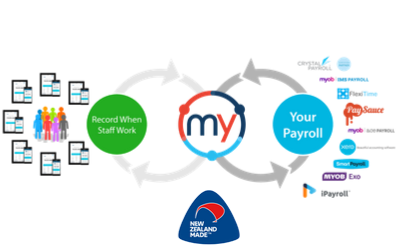
Want a FREE, No obligation trial of MyTimesheets? - you can do that here
Lately, we’ve been thinking a lot about "Timesheet Creep" and how best to reduce the cost of managing this.
The question to ask yourself is not – “Do I have a time theft problem” but rather "Do I have a Timesheet Creep problem and what can I do about it to ensure we are accurately recording the hours' staff work in a way which is fair, accurate and equitable to both the employee and the business”
Many of the issues are backed up by the study conducted by the American Payroll Association.
This involves employees recording start and finish times in their favour, long lunches and breaks, tardiness, early departures, etc. While cribbing a minute here and there may not seem like a lot, it soon adds up when you multiply each incident by the number of staff you have. Even if it is only 5 minutes per day that equates to around $500 a year per employee in extra wages (based on the minimum wage of $17.70 per hr)
The study show the average weekly time creep was up to 4 hours per employee!
It was found that the calculation and/or keying error rate was up to 8% of total payroll in companies that use time sheets. Even if you take a conservative view and you use a figure of 1% what would 1% of you annual wage bill equate to?
Added to this, when you use a manual system like paper time sheets, an employee’s data will be touched over around 35 times every pay period, before they receive their pay into their bank account. The opportunity for error is massive.
While this less of an issue we have seen cases of both Buddy Punching where employees clock for each other and also situations where employees complete each others timesheet. The average loss as a result of clocking in for each other or completing each other’s time sheet was between 2-5% of the annual wage bill
The study showed that manual calculation and keying of time sheets takes approximately 5 minutes per time sheet.
Another issue often overlooked by employers using manual systems is the record keeping requirements of the Employment Relations Act, Holidays Act and the Health and Safety in Employment Act.
All employers must keep a record of the hours worked each day, including start time, finish time and any non-paid breaks taken. These systems will ensure you meet your record keeping obligations under these under these acts.
It is true that implementing a new system will have a cost but what are the costs of not changing? The research indicated manual time and attendance systems like paper timesheets can add up to 8% to your annual wage bill.
The most telling finding was that most employers who experienced these issues were not aware they had a problem.
This is not a business strategy. If you don’t compare your current method to the alternatives you will never find out if there is a better way.
If you are honest with yourself, how many of these issues apply to your business and what are manual systems like paper timesheets costing you every year?
One of the key benefits of automating your employee attendance is that computers know how to calculate time, total and collate data, apply rules, transfer data and they do it all at speed.
This removes the factor of human error (intentional or accidental).
If your employees clock in and out as they should using a system like MyTimesheets, they can trust that they will be paid accurately and on time for the hours they work, as the system will work out everything based on the company’s rules and it will also speed up the process.
You will be able to trust that you are paying your employees accurately for the hours they work, and, in the process, you will be saving money with more accurate data and reduced processing time from not having to manually calculate or key anything into your payroll.
With modern time and attendance systems like MyTimesheets, you can see your employees times in “real-time” from any internet connected device. Therefore, if you still don’t trust them you can check where and when they clocked.
As a bonus, experience has shown us that automating employee time and attendance will pay for itself in less than three months with typical savings of between 2% and 15% of annual wages.
